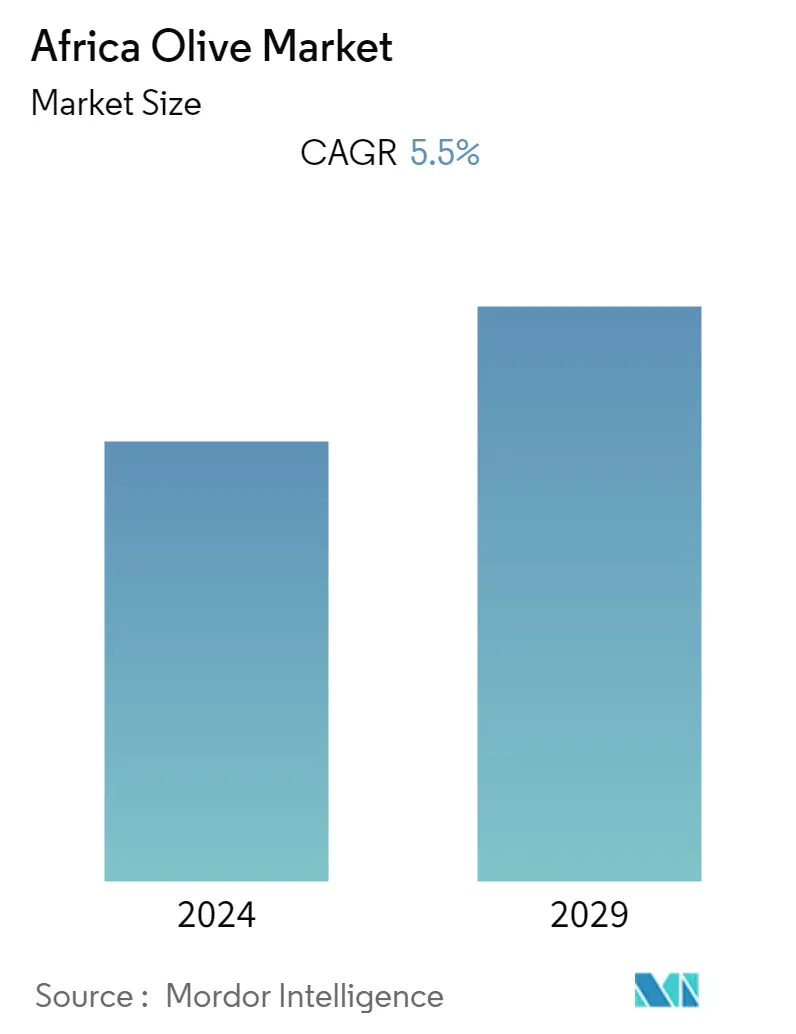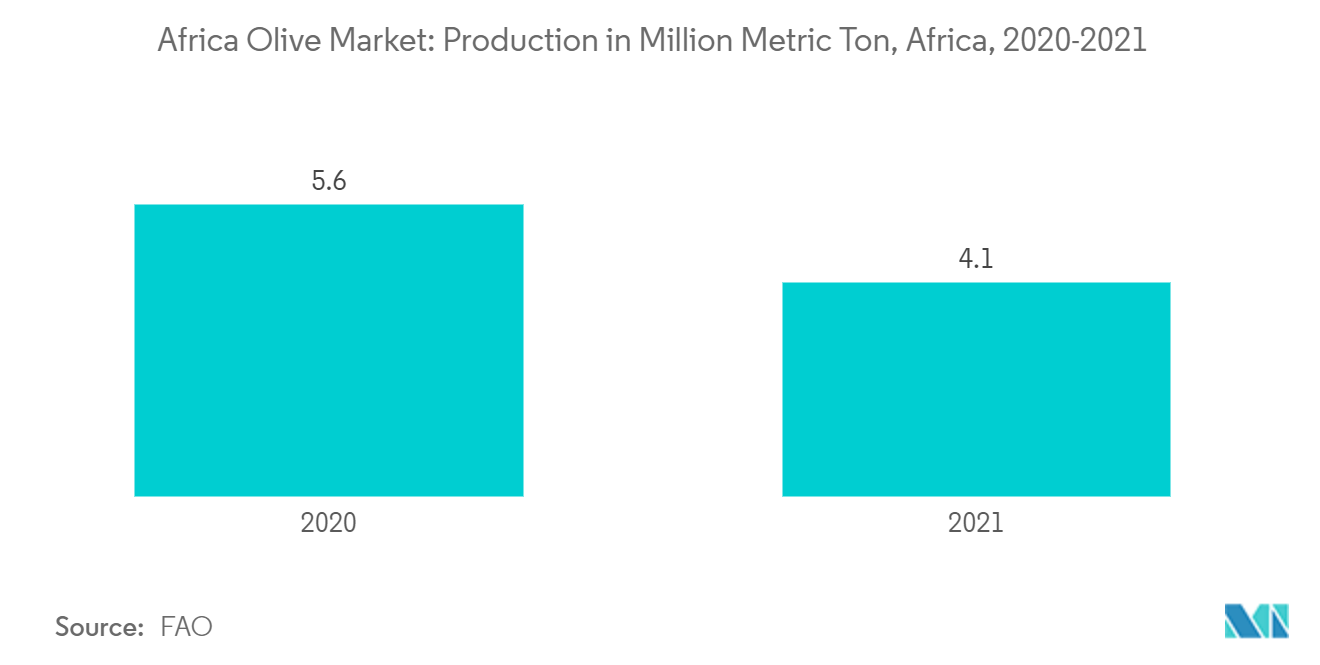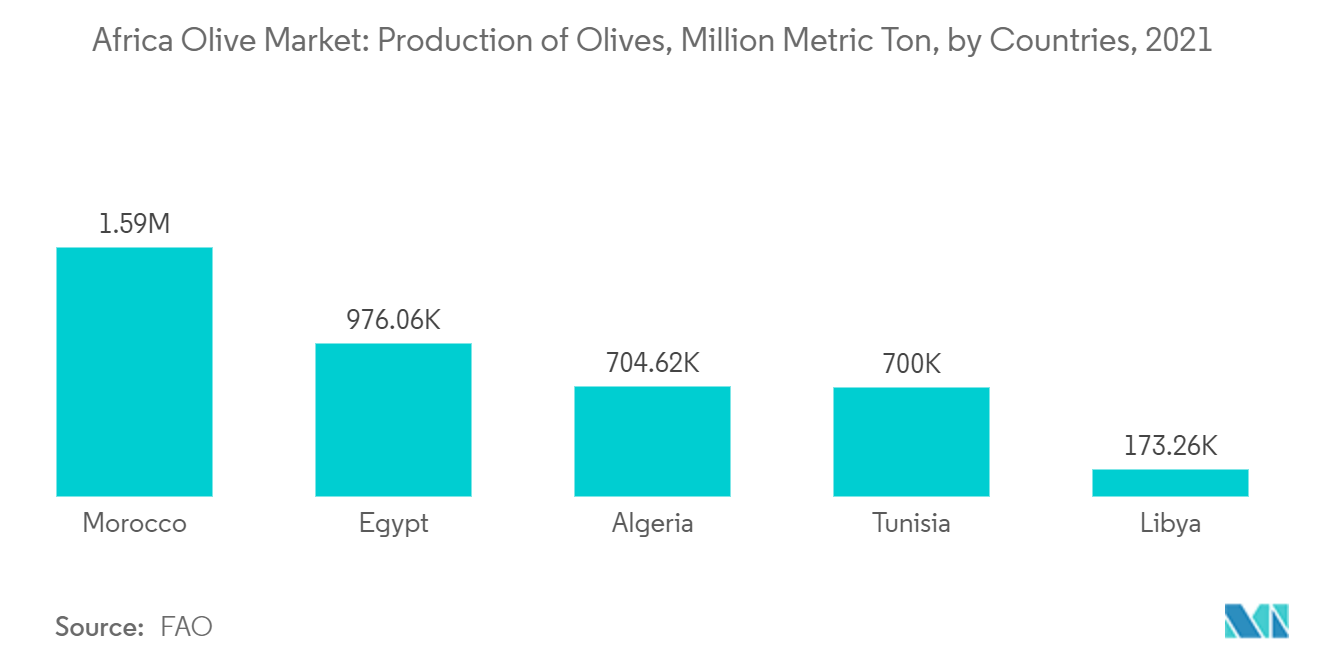Africa Olives Market Size

| Study Period | 2019 - 2029 |
| Base Year For Estimation | 2023 |
| Forecast Data Period | 2024 - 2029 |
| Historical Data Period | 2019 - 2022 |
| CAGR | 5.50 % |
Major Players*Disclaimer: Major Players sorted in no particular order |
Africa Olives Market Analysis
The Africa olive market is expected to register a CAGR of 5.5% during the forecast period.
- Olive oil, cereals, fruit and vegetables, and dates have long been the foundation of agriculture in Africa, and efforts are being made to modernize the sector through the development of agri-business. Yet, agriculture remains largely dominated by small family farms. In addition, initiatives to reorganize production to boost efficiency and equity are being implemented, notably in the form of cooperatives. Morocco is the largest producer, with 1.5 million in 2021, followed by Egypt, Algeria, and Tunisia, some of the other top olive production countries in Africa.
- In 2023, Spanish olive oil consumers are likely to turn to other markets like Morocco for the product, as prices remain high due to rising production costs and drought, standing at more than five euros per liter for extra virgin olive oil and around five euros for virgin and lampante olive oil. Despite this price increase, Spanish consumers continue to buy olive oil because they have no other alternative. Sunflower oil has also become more expensive after the Russian invasion of Ukraine.
- The government has prioritized improving irrigation, and increasing market productivity since olive has the potential for much more growth, especially in terms of higher value-added organic olive oil. Some factors driving the olives market are the rise in the demand for olive oil, dietary benefits, and pharmaceutical uses, which will boost the market's growth during the forecast period.
Africa Olives Market Trends
This section covers the major market trends shaping the Africa Olive Market according to our research experts:
Rising Demand for Olive Oil owing to its Health Benefits
- Olive oil consumption has grown faster than production over the past three years as consumers are shifting their choices to match a healthier post-pandemic lifestyle. The most significant trends the olive industry needs to explore in 2023 are consumers' focus on healthy eating, plant-based and Mediterranean-style diets, oleo tourism, and olive-based cosmetics.
- In addition, the price of other cooking oils had increased steeply over the past year, compared with only a minor increase in the price of olive oil, encouraging consumers to choose olive oil instead. This will increase consumer demand and the market's growth in the forecasted period.
- The adaptability of olive plants to all the agro-climatic zones of Morocco, government initiatives to increase olive production, and demand for Moroccan olives in the international market are some of the prime reasons for high olive production in Africa. Morocco is also one of the leading olive exporters in the world. Morocco Gold extra virgin olive oil is the finest example of Moroccan olive oil production, which comes from a unique source with unique micro-climate and geological conditions. Moroccan extra virgin olive oil is prized for its high polyphenol compound and remarkable health benefits to reduce inflammation, lower blood pressure, and protect against heart disease and stroke. Furthermore, extra virgin olive oil is rich in antioxidants, which can help to boost overall health and wellness.
- Similarly, the olive oil quality project enacted in the country with the help of the United Nations Food and Agriculture Organization (FAO) and the European Bank for Reconstruction and Development (EBRD) continues to support the Moroccan olive oil sector. Hence, the above factors will boost the market opportunities for the olive industry in the coming years.

Morocco Leads in the Olive Production
- Morocco is one of the world's leading producers of extra virgin olive oil due to the country's ideal climate and rich soil. Morocco has more than four million olive trees, the primary source of extra virgin olive oil production. The country's warm days and cool nights create the perfect environment for olives to grow to their full potential. All these factors combine to make Morocco a top producer of extra virgin olive oil and in high global demand.
- The main olive production regions in Morocco are Fez-Meknes and Marrakech-Safi, the largest in production at the national level. Government initiatives to increase olive production and demand for Moroccan olives in the international market are some of the prime reasons for high olive production in Africa.
- Morocco is quickly becoming one of the largest olive oil producers outside of the European Union, joining the likes of Turkey and Tunisia, which produced 227,500 tons and 240,000 tons of olive in the country. According to International Olive Council (IOC), the production of olives exceeded 150,000 tons in 2020-21r, which increased compared to the previous year with 145,000 tons.
- According to the Ministry of Agriculture, the national production of olives for the 2021-2022 season amounted to about 1.96 million tons, an increase of 21% compared to the previous season. Rising production figures are the fruit of the long-term plan for olive growing expansion in the country, quickly becoming one of the most relevant olive oil producers outside of Europe. This is expected to grow the market during the forecasting period.

Africa Olives Market News
- October 2022: According to the Ministry of Agriculture, olive production in Morocco increased by 21% in 2022 due to favorable climatic conditions with a rainfall of 309 millimeters and an increase in olive oil plantations in line with the Green Generation plan for 2020-2030. The country witnessed a higher value in the export of olive oil, with USD 41 million compared to the previous year.
- January 2022: The European Bank for Reconstruction and Development (EBRD) confirmed a new USD 6.2 million loan to the Campagnie General des Industries Alimentaires(COGIA), one of the country's major food manufacturers, to help strengthen the olive farming sector in Tunisia. These funds will be used to develop irrigation projects and foster production, bottling, and exports.
Africa Olives Market Report - Table of Contents
1. INTRODUCTION
- 1.1 Study Assumptions and Market Definition
- 1.2 Scope of the Study
2. RESEARCH METHODOLOGY
3. EXECUTIVE SUMMARY
4. MARKET DYNAMICS
- 4.1 Market Overview
- 4.2 Market Drivers
- 4.3 Market Restraints
- 4.4 Value Chain Analysis
5. MARKET SEGMENTATION
-
5.1 Geography
- 5.1.1 Morocco
- 5.1.1.1 Production Analysis
- 5.1.1.2 Consumption Analysis and Market Value
- 5.1.1.3 Import Market Analysis (Volume and Value)
- 5.1.1.4 Export Market Analysis (Volume and Value)
- 5.1.1.5 Price Trend Analysis
- 5.1.2 Algeria
- 5.1.2.1 Production Analysis
- 5.1.2.2 Consumption Analysis and Market Value
- 5.1.2.3 Import Market Analysis (Volume and Value)
- 5.1.2.4 Export Market Analysis (Volume and Value)
- 5.1.2.5 Price Trend Analysis
- 5.1.3 Tunisia
- 5.1.3.1 Production Analysis
- 5.1.3.2 Consumption Analysis
- 5.1.3.3 Import Market Analysis (Volume and Value)
- 5.1.3.4 Export Market Analysis (Volume and Value)
- 5.1.3.5 Price Trend Analysis
- 5.1.4 Egypt
- 5.1.4.1 Production Analysis
- 5.1.4.2 Consumption Analysis
- 5.1.4.3 Import Market Analysis (Volume and Value)
- 5.1.4.4 Export Market Analysis (Volume and Value)
- 5.1.4.5 Price Trend Analysis
- 5.1.5 Libya
- 5.1.5.1 Production Analysis
- 5.1.5.2 Production Analysis
- 5.1.5.3 Import Market Analysis (Volume and Value)
- 5.1.5.4 Export Market Analysis (Volume and Value)
- 5.1.5.5 Price Trend Analysis
6. MARKET OPPORTUNITIES AND FUTURE TRENDS
** Subject To AvailablityAfrica Olives Industry Segmentation
Olive is an evergreen tree, Olea europaea, of the Mediterranean and other warm regions, cultivated chiefly for its fruit.
The Africa olive market is segmented based on Geography ( Morocco, Algeria, Tunisia, Egypt, and Libya). The report includes production analysis (volume), consumption analysis (value and volume), export analysis (value and volume), import analysis (value and volume), and price trend analysis.
The report offers the market size and forecast in both value (USD million) and volume (metric ton).
| Geography | Morocco | Production Analysis |
| Consumption Analysis and Market Value | ||
| Import Market Analysis (Volume and Value) | ||
| Export Market Analysis (Volume and Value) | ||
| Price Trend Analysis | ||
| Geography | Algeria | Production Analysis |
| Consumption Analysis and Market Value | ||
| Import Market Analysis (Volume and Value) | ||
| Export Market Analysis (Volume and Value) | ||
| Price Trend Analysis | ||
| Geography | Tunisia | Production Analysis |
| Consumption Analysis | ||
| Import Market Analysis (Volume and Value) | ||
| Export Market Analysis (Volume and Value) | ||
| Price Trend Analysis | ||
| Geography | Egypt | Production Analysis |
| Consumption Analysis | ||
| Import Market Analysis (Volume and Value) | ||
| Export Market Analysis (Volume and Value) | ||
| Price Trend Analysis | ||
| Geography | Libya | Production Analysis |
| Production Analysis | ||
| Import Market Analysis (Volume and Value) | ||
| Export Market Analysis (Volume and Value) | ||
| Price Trend Analysis |
Africa Olives Market Research FAQs
What is the current Africa Olive Market size?
The Africa Olive Market is projected to register a CAGR of 5.5% during the forecast period (2024-2029)
What years does this Africa Olive Market cover?
The report covers the Africa Olive Market historical market size for years: 2019, 2020, 2021, 2022 and 2023. The report also forecasts the Africa Olive Market size for years: 2024, 2025, 2026, 2027, 2028 and 2029.
Africa Olive Industry Report
Statistics for the 2024 Africa Olive market share, size and revenue growth rate, created by Mordor Intelligence™ Industry Reports. Africa Olive analysis includes a market forecast outlook to 2029 and historical overview. Get a sample of this industry analysis as a free report PDF download.



